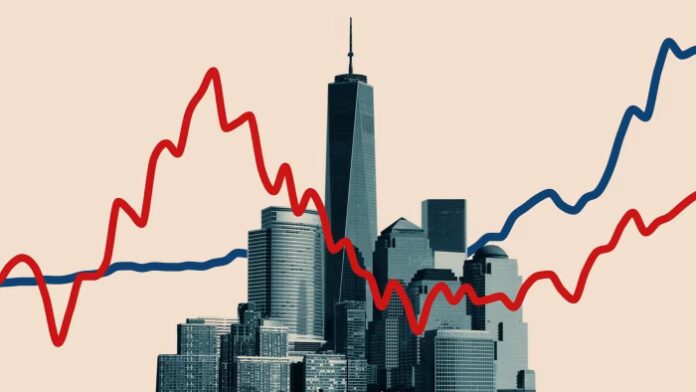Unlock the Editor’s Digest for free
Roula Khalaf, Editor of the FT, selects her favourite stories in this weekly newsletter.
Good morning. Some “errors and connectivity issues” at one of Amazon’s data centres yesterday disrupted service across several other big names — ChatGPT, Lyft, Starbucks and Coinbase among them. In the circular tech world, is a problem for one investment a problem for all? Let us know your thoughts: unhedged@ft.com
Europe’s (relative) comeback
Is the era of European underperformance over? The continent is having a good year. The Stoxx 600 is outperforming the S&P 500 in euro and dollar terms:


Notice that in the “liberation day”-induced sell-off in early April, the Stoxx 600’s losses were smaller than the S&P 500’s. This isn’t just a one-off, but a a pattern that has held true since 2022, according to Maximilian Uleer at Deutsche Bank. Because of the extreme concentration in the S&P 500, US market downturns have become sharper than in Europe, Uleer points out:
‘When the US sneezes, Europe catches a cold’. It held true for 15 years. But it is time to rethink . . . The new wisdom is: ‘When the US sneezes, Europe says Gesundheit’. Current bubble, capex and credit worries are more associated with US than Europe
It’s useful to recall how the valuation and performance gaps between Europe and the US became so large in the first place. There was the European sovereign debt crisis during a large portion of the 2010s; low productivity; a poor demographic outlook; political uncertainty; and weak growth. And while the US had the Magnificent Seven and the broader tech industry to power the market and economic growth higher, there isn’t a European equivalent, as Unhedged has noted before. In many ways, the US had what Europe didn’t, according to Uleer:
Higher valuations of the biggest seven companies . . . Higher political stability, stronger economic growth, and better liquidity in the US [have] led to the valuation difference across sectors.
Some of these drivers of relative underperformance are easing up. The Eurozone manufacturing PMI crossed 50 this August, indicating an expansion, for the first time since March 2022. Macroeconomic conditions seem to be improving. Looser fiscal policy, particularly in Germany, in support of greater defence and infrastructure spending is expected to help stimulate the economy a bit. The imbalances across Eurozone countries are not as severe as they were prior to the sovereign debt crisis, according to Andrew Kenningham at Capital Economics.
The policymaking environment also appears more stable by comparison. Or, as Kenningham describes it, “US policymaking has made Europe look like a more attractive investment location, at least in relative terms”.
To Kenningham’s point: how much of European outperformance is simply a functionof worsening sentiment towards the US? For all the talk about improving economic growth, the IMF’s real GDP forecast for the EU is just 1.4 per cent in both 2025 and 2026. The fiscal risks, meanwhile, look similar in the two regions thanks to ever-increasing US government debt levels. Charts courtesy of Uleer:

All that to say — for all the improvements in European sentiment, economic dynamism remains elusive. The recent developments don’t fix the continent’s structural growth constraints. Barring meaningful deregulation and more competitive changes such as a single financial market, European optimism is a relative rather than an absolute phenomenon.
What the other labour data says
We are at week four of the US government shutdown. Earlier on, we had hoped this shutdown would be much like earlier ones — shortlived and inconsequential. While we can expect September’s CPI numbers to belatedly come out on October 24 (more than a week late), there’s still no indication of when we can expect the Bureau of Labor Statistics’ monthly payroll data or the Job Openings and Labor Turnover Survey.
As we’ve pointed out before, though, we do have some alternative forms of data we can look towards. For one, most states are still submitting weekly jobless claims. Going off of those numbers, economists from Goldman Sachs and JPMorgan estimate the number of initial jobless claims dipped to 217,000 in the week ending October 11, compared to 235,000 the prior week. Employment indices from regional Fed surveys are another useful measure. The Chicago Federal Reserve’s real-time unemployment rate forecast has unemployment for September likely coming in at 4.3 per cent, which is unchanged from August’s actual unemployment rate:

For the most part, the private data paints a similar picture — the labour market remains sluggish but isn’t yet spiralling. Total job postings on Indeed as of the week ending October 10, continue to remain lower than the same period a year ago, but are not falling off at a faster rate:

The real bad news might come to us once the shutdown is over and the official data returns. Samuel Tombs of Pantheon Macroeconomics notes federal employees who took deferred resignation offers earlier this year will be coming off payrolls in October. He estimates this could bring the headline payrolls number to about zero. And, of course, the increasing uncertainty stemming from not only the shutdown, but also the seeming revival of President Donald Trump’s trade war chaos will weigh on businesses’ outlooks and willingness to invest and hire.
And don’t forget that with the shutdown, data collection for October is also on pause, meaning even after it ends, we may be stuck. The fallout from shutdowns is not necessarily linear.
One good read
Source link





